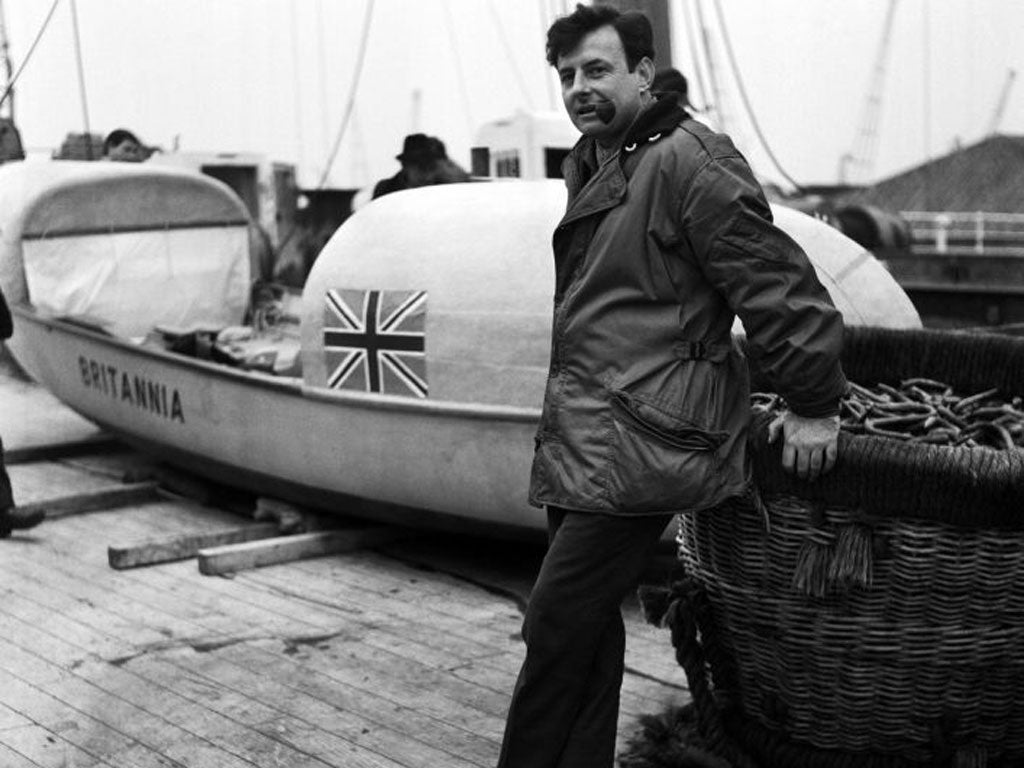John Fairfax: Adventurer who became the first man to row solo across the Atlantic ocean

John Fairfax, self-styled "professional adventurer," fulfilled a boyhood dream when he became the first recorded person to row solo across the Atlantic Ocean in 1969.
It made him an international celebrity. Bristling with feats that would not seem out of place in an Indiana Jones, James Bond or Boys' Own caper, Fairfax's CV was the antithesis of the mundane; big-game hunter, smuggler, pirate, adventurer, mink farmer, professional gambler.
Having been close to insanity, survived a shark attack, fallen overboard, battled storms, violent winds, blisters, diarrhoea and exhaustion, Fairfax landed at Hollywood Beach, Florida on 19 July 1969, six months after setting out from Las Palmas in the Canary Islands, following a journey elongated by the wind from 3,600 miles to around 5,000 miles. Tanned, tired and about 20 pounds lighter, he declared he would celebrate with "a nice steak, a bottle of Scotch and two aspirin."
His purpose-built 22ft orange craft, Britannia, conceived by the renowned English designer Uffa Fox, was self-bailing, self-righting and part-covered. Fairfax survived the extra mileage by eating up to eight pounds of fish per day, converting sea water into drinking water, and, on the odd occasion, scrounging food, water and a shower from passing ships. On his 32nd birthday he wrote in his log that he felt "a hundred." He navigated with a sextant and by the stars.
A man who thought nature was what he called "a worthy challenge", Fairfax attributed his success to his buccaneer days – and "a great teacher", when he honed his navigational skills while operating as a pirate's apprentice before eventually captaining his own boat and smuggling guns, cigarettes and whisky and "making my first million."
Born in Rome, in 1937, to a Britishfather, who worked for the BBC inLondon, and a Bulgarian mother, John Fairfax barely knew his father. Atthe age of six he joined the Italian boy scouts and learned to cook, campand trap, though he was later thrown out for shooting live rounds at other scouts. Shortly afterwards, his parents divorced and he moved to Argentina with his mother.
By his own account, aged 13 and with a desire "to go to the Amazon and live like Tarzan," Fairfax became a hunter, regularly appearing after three-to-four month trips with skins for sale, mostly jaguar and ocelot. In 1957, he published a book in Spanish about his exploits, Vagabundos Bajo El Sol [Vagabonds Under the Sun].
Inheriting $10,000 in 1959, Fairfax travelled to New York before completing a road trip across America to San Francisco, whereupon he befriended a Chinese girl. When down to his last $150 he left for Argentina, cycling to Guatemala, and then hitch-hiking to Panama, where he joined up with a smuggler. "I'd like to try my hand at smuggling," Fairfax told the captain, who took him to a brothel and put him in bed with two whores. If he survived the night and they approved of him, then he would be hired. Fairfax was extremely drunk but survived, and soon became his right-hand man before leaving to skipper his own vessel.
After three years, piracy lost its attraction. Following a botched hijacking, Fairfax evaded the authorities by hiding in a brothel before slipping away to Jamaica, where he worked for a year as a fisherman. He eventually returned to Argentina, where he briefly ran a mink farm.
In 1966, Fairfax read about the exploits of John Ridgway and Chay Blyth rowing the Atlantic together. Fairfax felt, he recalled, "a sudden sense of urgency. If I didn't solo it soon, it was going to be done by somebody else."
His fascination with rowing had begun in childhood after he read a Reader's Digest article about two Norwegian adventurers who in 1896 became the first men to row across the Atlantic. He trained for two years, rowing everyday on the Serpentine in Hyde Park or on the Thames, as well as running, swimming and weightlifting. Bronzed, sinewy and, as ever, charismatic, he persuaded a businessman, Martin Cowling, to back him. Although there was no support boat and no chase plane, his epic voyage was a success and he became a media sensation.
Less than two years later, Fairfaxentered the record books for a second time, in April 1972, when he and hisgirlfriend, Sylvia Cook, (who couldn't swim) rowed across what he dubbed "the Everest of the sea," the Pacific Ocean, a year-long ordeal during which their craft was thought lost. Their new boat, Britannia II, also a Fox design, was just 36ft. Their 8,000-mile journey began on 26 April 1971 in San Francisco and they rowed for 361 days until reaching Hayman Island, off the coast of Australia.
They survived ferocious storms, which blew them off-course, and a cyclone, when they were forced to strap themselves in leather harnesses, while Fairfax suffered a shark attack when fishing for food. Unreachable by radio for a time, they were presumed lost. "It was a miserable journey," Fairfax said at the end of the voyage. "I don't care if I never touch another oar."
In the 1970s, Fairfax wrote two books about his ocean crossings, Britannia: Rowing Alone Across the Atlantic and, with Cook, Oars Across the Pacific.
He is survived by his wife of 31 years, Tiffany, an astrologer. The couple moved to Las Vegas in 1992, where he pursued his penchant for gambling and became an expert at baccarat, from which he made a living.
John Fairfax, adventurer: born Rome 21 May 1937; married 1981 Tiffany; died Henderson, Nevada 8 February 2012.
Subscribe to Independent Premium to bookmark this article
Want to bookmark your favourite articles and stories to read or reference later? Start your Independent Premium subscription today.

Join our commenting forum
Join thought-provoking conversations, follow other Independent readers and see their replies